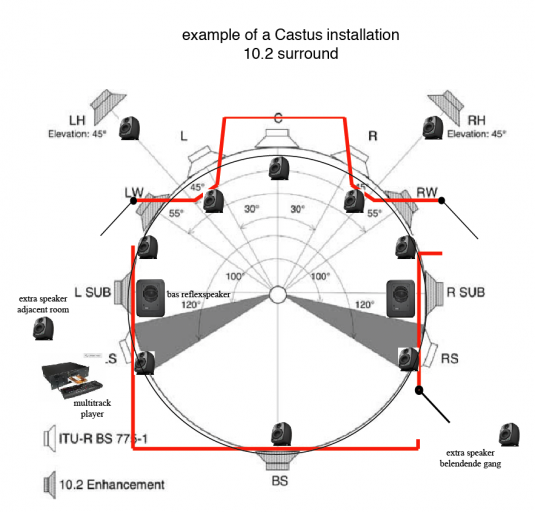
CASTUS culture.music.media is small production company that is specialized in music projects, cd and dvd recordings, radio and television productions, cultural- and special events.
Last year Castus installed it’s first super-surround installation in a Dutch castle. The installation consists of 14 speakers and is based on Tomlinson Holman’s 10.2 surround specifications. Two effect speakers were installed in adjacent rooms. Holman is responsible -among others- for the development and name giving of discrete 5.1 surround. He also developed the THX (Tom Holman Experiment) sound specifications for cinema’s worldwide as result of the experiences with Starwars films of George Lucas. There are just a few 10.2 installations worldwide and in Europe this is the only one installation.
We don’t just install surround installations. We actually produce sound experiences. We develop, create and produce the content for the surround shows. Special stories written for the location, unique surround effects and 10.2 recordings, professional actors, specially mixed 10.2 music recordings etc. These surround sound productions are tailor-made for the customer, whether it is a historic place, a museum, a special event, a show etc.
In the next period Castus will be producing more surround ‘experiences’ for different and unique places in the Netherlands and abroad.
Introducing the 10.2 Surround Format
Actually it isn't quite so new considering Tom Holman has shown this 10.2 technology for years and has approx. 10 such permanent facilities that he's built for others worldwide including -one at Bjorn's Audio Video in San Antonio. The practicality of this format is somewhat limited due to logistics of integrating the additional speakers for its realization and the fact that it does require significantly more processing power. The motivation behind 10.2 was to demonstrate that the audio industry focus on higher sampling rates is not going to produce the most perceivable difference. Since the limits of human perception have already been met in word length and sampling rate, the next revolution will inevitably be in the number of audio channels to better match human spatial sound perception.
In evaluating the important improvements which could be made to standard 5.1 in order to improve the surround sound experience, the first place to fill in is to the sides. Psychoacoustics research says that side reflections are important in the perception of source width and the preferred direction for such reflections is at 55 degrees. In response to this research, 10.2 adds new width Left Wide and Right Wide speakers and channels (with a 35 ms delay to simulate the first reflection of a typical shoebox shaped concert hall). These additional tracks are added in the mixing engineering phase.
A single discrete Surround Back speaker is utilized in 10.2 to fill in the wide gap left there by the standard surround speakers at ±110 degrees. The next thing to be reproduced was the ceiling reflection above the orchestra in concert halls. A Left Height and Right Height channel were subsequently added to more accurately recreate "depth" in the soundstage.
Finally, two independent subwoofer channels are provided, each bass managed from its respective side and also available for separate left and right LFE tracks. On most tracks this will still result in a dual mono subwoofer system, but the potential for greater fidelity is there with independent Left & Right subwoofer channels. It’s believed that although bass waves below 80 Hz are omnidirectional, there is research evidence that shows stereo bass can improve the sense of envelopment and add a further sense of realism to the surround experience.

10.2 Speaker Layout Diagram and Explanation
The above diagram illustrates the placement of the additional speakers along with the standard 5.1 ITU setup. The channel naming is as follows:
L, R, C, LS, RS, LHeight (LH), RHeight (RH), LWide (LW), RWide (RW), Back Surround (BS), L SUB, R SUB
To the standard 5.1 layout, 10.2 adds speakers based on both acoustical and psychoacoustical considerations. Side wall reflections in concert halls, for example, have been found to add to the sense of spaciousness when implemented properly. Ando found through extensive listening tests (Y. Ando, "Concert Hall Acoustics", Springer, Berlin, 1985) that there is a preferred direction for first reflections, preferred spectrum, and preferred delay. The LW and RW speakers are intended to reproduce such reflections picked up by wide or outrigger microphones in 10.2 recordings. A second, and equally important, role for the wide speakers is that they shorten the gap between front and surround speakers. This allows more accurate placement and panning of sounds from front to back.
The second most important reflection in a concert hall, after the side, is the one from the proscenium above the stage. The Left and Right Height channels are designed to reproduce the sound from that direction. They are also appropriately processed and delayed to seamlessly blend with the direct sound from L, C, and R.
Finally, the back surround speaker is used to fill in the gap between the left and right surrounds to allow for both discrete placement and seamless surround ambience.
The Need for 10.2 over Conventional 5.1, Based on Human Perception of Sound
5.1 channels (a term coined by Tom Holman at a standards meeting in the early 1990s) was the minimum number of channels needed to reproduce a front soundstage and an ambient surround impression. It is, by no means, the limit as human perception can discern many more directions. 10.2 was designed to fill in some of the perceptual gaps that are left unfulfilled by 5.1. For example, Makous and Middlebrooks (J.C. Makous and J.C. Middlebrooks, "Two Dimensional Sound Localization by Human Listeners," J. Acoustical Soc. of America, vol. 87, no. 5, May 1990, pp. 2188-2200.) showed that human localization is much more precise in the horizontal plane and the front hemisphere and degrades for the sides and rear. That would indicate that for a fixed number of channels, more should be allocated to the front than the back. Unfortunately, the surround industry has moved in the opposite direction by adding more surround channels than front channels (e.g., in 7.1 systems). While additional surround channels can be useful in reproducing ambient sound and improve audience coverage in large rooms, current systems do not map well with the needs of human perception.
In other work by Rebscher and Theile (R. Rebscher and G. Theile, "Enlarging the Listening Area by Increasing the Number of Loudspeakers," 88th AES Convention, 1990, Preprint No. 2932.) it was shown that there is a direct relationship between the size of the useful listening area and the number of screen (front) loudspeakers. Moving from 2 to 3 and then to 5 front speakers (as found in 10.2) the area in which imaging distortion is minimized increases from a few centimeters to over 3 meters




